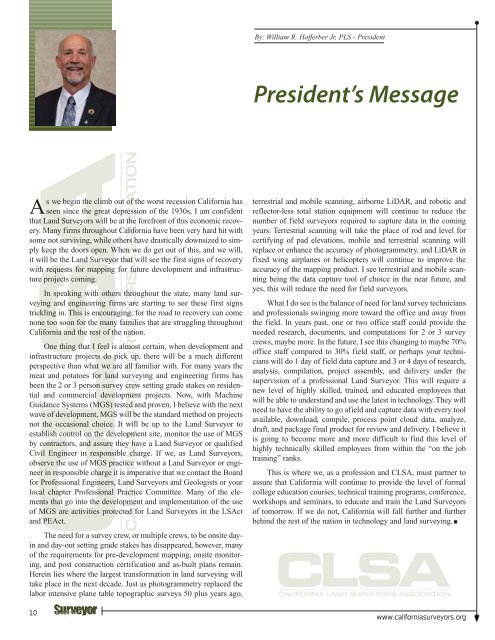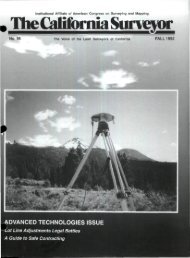Sacramento Surveyors Visit the NGS Airborne Gravimeter - CLSA
Sacramento Surveyors Visit the NGS Airborne Gravimeter - CLSA
Sacramento Surveyors Visit the NGS Airborne Gravimeter - CLSA
You also want an ePaper? Increase the reach of your titles
YUMPU automatically turns print PDFs into web optimized ePapers that Google loves.
By: William R. Hofferber Jr, PLS - President<br />
President’s Message<br />
As we begin <strong>the</strong> climb out of <strong>the</strong> worst recession California has<br />
seen since <strong>the</strong> great depression of <strong>the</strong> 1930s, I am confident<br />
that Land <strong>Surveyors</strong> will be at <strong>the</strong> forefront of this economic recovery.<br />
Many firms throughout California have been very hard hit with<br />
some not surviving, while o<strong>the</strong>rs have drastically downsized to simply<br />
keep <strong>the</strong> doors open. When we do get out of this, and we will,<br />
it will be <strong>the</strong> Land Surveyor that will see <strong>the</strong> first signs of recovery<br />
with requests for mapping for future development and infrastructure<br />
projects coming.<br />
In speaking with o<strong>the</strong>rs throughout <strong>the</strong> state, many land surveying<br />
and engineering firms are starting to see <strong>the</strong>se first signs<br />
trickling in. This is encouraging, for <strong>the</strong> road to recovery can come<br />
none too soon for <strong>the</strong> many families that are struggling throughout<br />
California and <strong>the</strong> rest of <strong>the</strong> nation.<br />
One thing that I feel is almost certain, when development and<br />
infrastructure projects do pick up, <strong>the</strong>re will be a much different<br />
perspective than what we are all familiar with. For many years <strong>the</strong><br />
meat and potatoes for land surveying and engineering firms has<br />
been <strong>the</strong> 2 or 3 person survey crew setting grade stakes on residential<br />
and commercial development projects. Now, with Machine<br />
Guidance Systems (MGS) tested and proven, I believe with <strong>the</strong> next<br />
wave of development, MGS will be <strong>the</strong> standard method on projects<br />
not <strong>the</strong> occasional choice. It will be up to <strong>the</strong> Land Surveyor to<br />
establish control on <strong>the</strong> development site, monitor <strong>the</strong> use of MGS<br />
by contractors, and assure <strong>the</strong>y have a Land Surveyor or qualified<br />
Civil Engineer in responsible charge. If we, as Land <strong>Surveyors</strong>,<br />
observe <strong>the</strong> use of MGS practice without a Land Surveyor or engineer<br />
in responsible charge it is imperative that we contact <strong>the</strong> Board<br />
for Professional Engineers, Land <strong>Surveyors</strong> and Geologists or your<br />
local chapter Professional Practice Committee. Many of <strong>the</strong> elements<br />
that go into <strong>the</strong> development and implementation of <strong>the</strong> use<br />
of MGS are activities protected for Land <strong>Surveyors</strong> in <strong>the</strong> LSAct<br />
and PEAct.<br />
The need for a survey crew, or multiple crews, to be onsite dayin<br />
and day-out setting grade stakes has disappeared, however, many<br />
of <strong>the</strong> requirements for pre-development mapping, onsite monitoring,<br />
and post construction certification and as-built plans remain.<br />
Herein lies where <strong>the</strong> largest transformation in land surveying will<br />
take place in <strong>the</strong> next decade. Just as photogrammetry replaced <strong>the</strong><br />
labor intensive plane table topographic surveys 50 plus years ago,<br />
10<br />
terrestrial and mobile scanning, airborne LiDAR, and robotic and<br />
reflector-less total station equipment will continue to reduce <strong>the</strong><br />
number of field surveyors required to capture data in <strong>the</strong> coming<br />
years. Terrestrial scanning will take <strong>the</strong> place of rod and level for<br />
certifying of pad elevations, mobile and terrestrial scanning will<br />
replace or enhance <strong>the</strong> accuracy of photogrammetry, and LiDAR in<br />
fixed wing airplanes or helicopters will continue to improve <strong>the</strong><br />
accuracy of <strong>the</strong> mapping product. I see terrestrial and mobile scanning<br />
being <strong>the</strong> data capture tool of choice in <strong>the</strong> near future, and<br />
yes, this will reduce <strong>the</strong> need for field surveyors.<br />
What I do see is <strong>the</strong> balance of need for land survey technicians<br />
and professionals swinging more toward <strong>the</strong> office and away from<br />
<strong>the</strong> field. In years past, one or two office staff could provide <strong>the</strong><br />
needed research, documents, and computations for 2 or 3 survey<br />
crews, maybe more. In <strong>the</strong> future, I see this changing to maybe 70%<br />
office staff compared to 30% field staff, or perhaps your technicians<br />
will do 1 day of field data capture and 3 or 4 days of research,<br />
analysis, compilation, project assembly, and delivery under <strong>the</strong><br />
supervision of a professional Land Surveyor. This will require a<br />
new level of highly skilled, trained, and educated employees that<br />
will be able to understand and use <strong>the</strong> latest in technology. They will<br />
need to have <strong>the</strong> ability to go afield and capture data with every tool<br />
available, download, compile, process point cloud data, analyze,<br />
draft, and package final product for review and delivery. I believe it<br />
is going to become more and more difficult to find this level of<br />
highly technically skilled employees from within <strong>the</strong> “on <strong>the</strong> job<br />
training” ranks.<br />
This is where we, as a profession and <strong>CLSA</strong>, must partner to<br />
assure that California will continue to provide <strong>the</strong> level of formal<br />
college education courses, technical training programs, conference,<br />
workshops and seminars, to educate and train <strong>the</strong> Land <strong>Surveyors</strong><br />
of tomorrow. If we do not, California will fall fur<strong>the</strong>r and fur<strong>the</strong>r<br />
behind <strong>the</strong> rest of <strong>the</strong> nation in technology and land surveying.<br />
www.californiasurveyors.org
















